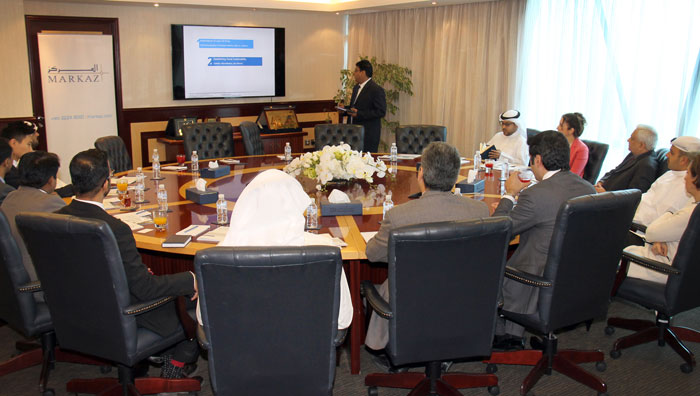Kuwait Financial Centre “Markaz” recently held a presentation on “Forecasting Sovereign Debt Issuances in GCC” in collaboration with Kuwait Banking Association (KBA). The presentation was delivered by Mr. M.R. Raghu, Head of Research at Markaz and Managing Director of Marmore MENA Intelligence, a research subsidiary of Markaz providing services of financial research and analysis of MENA economies, markets, and companies in the MENA region.

Photo: Raghu presents to banks’ representatives
On an overall basis for 2016, Raghu stated that the financing need for GCC countries to be at USD 151.3 bn of which USD 78.1bn is expected to come from reserves (52%), USD 57.7bn from domestic & international bond issuances (38%) and the rest through loans (10%). Overall, GCC governments are expected to raise between USD285-390 bn cumulatively through 2020 through local and international bonds.
Raghu said that the low oil prices has altered the fiscal landscape of GCC countries as the prized fiscal surplus registered in erstwhile years has flipped into large scale deficits to the tune of USD 160bn in 2015 and 2016 respectively. In 2015, the deficit was partly met by domestic bond issuances and the remaining by liquidating reserves held in Sovereign Wealth Funds (SWFs). Saudi Arabia for the first time in 8 years issued local debt to raise approx. USD 26bn from domestic banks and utilized almost USD 100bn of its reserves.
Raghu outlined that the impact of lower oil revenues has visibly impacted the Kuwaiti banks’ deposit mobilisation process, as government deposits account for sizeable portion. Fall in deposits growth coupled with governments drawing down on their savings and placement of domestic bonds by the governments with the local banks has usurped liquidity in the regional financial system causing interbank rates to rise. Though, the banks are well capitalized, they may not be able to act as the sole source of funding avenue for the governments. Rising debt levels for the GCC governments and uncertain outlook regarding oil prices, which determines the debt servicing capabilities, has led to higher cost of insurance for insuring government debt as evidenced by the widening spreads for Credit Default Swaps (CDS).
While UAE, Kuwait Saudi Arabia and Qatar boast of robust fiscal reserves, Bahrain and Oman have minimal reserves by comparision.The sovereign ratings of Bahrain, Oman and Saudi Arabia have been downgraded in the recent weeks. Further, lack of clarity regarding debt management policies of few GCC countries has caused wide spread speculation regarding the way the deficit could be financed. This uncertainity has resulted in fixed income investors demanding wider spreads for outstanding issues in GCC region.
To forecast the sovereign debt issuance we have assumed assumptions regarding the way the deficit would be financed either by drawing down on the reserves or through raising debt. While Qatar and Oman have clearly provided indications regarding their approach to plug the deficit, Saudi Arabia and Bahrain budgetary documents fall short of such discussion.
Based on our analysis, the new debt issuances by the GCC government could usher in a new era for GCC fixed income markets. The challenging environment posed by lower oil prices should be converted into an opportunity to develop the domestic debt markets. In this regard, establishment of debt management office and regulatory framework to clearly communicate to the markets is necessary. Though domestic debt issuance allows for easier and faster way to raise capital at lower credit spreads, it could usurp liquidity and ‘crowd out’ borrowing space for private borrowers. On the other hand, jumbo issuances are possible in international issuances while it increases the vulnerability due to increased exposure to foreign debt.
Having said that, we feel that the GCC fixed income offers higher risk-return attributes than the developing and emerging markets. Lower correlation with other asset classes including equities argues favorably for their inclusion in an investor portfolio. The fact that all the currencies are pegged provides comfort to the investor as it helps avoid currency risk. However, geopolitical risks and uncertainty regarding oil price could affect the bond performance.
###
About Kuwait Financial Centre “Markaz”
Kuwait Financial Centre K.P.S.C “Markaz”, established in 1974, is one of the leading asset management and investment banking institutions in the Arabian Gulf Region with total assets under management (AUM) of over KD1 billion as of December 31, 2015 (US3.44 billion). Markaz’ shares are listed on the Kuwait Stock Exchange (KSE) since 1997.
For further information, please contact:
Alrazi Al Budaiwi
Media and Communication
Kuwait Financial Centre K.P.S.C "Markaz"
Tel: +965 2224 8000 ext. 1800
Fax: +965 2249 8740
Email: [email protected]
Url: www.markaz.com

